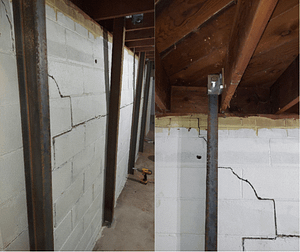8 Easy Facts About Best Basement Waterproofing Explained
8 Easy Facts About Best Basement Waterproofing Explained
Blog Article
Best Basement Waterproofing Fundamentals Explained
Table of ContentsBest Basement Waterproofing Things To Know Before You BuyBest Basement Waterproofing Things To Know Before You Get ThisThe Facts About Best Basement Waterproofing UncoveredThe Best Guide To Best Basement WaterproofingThe Ultimate Guide To Best Basement Waterproofing
AdvantaClean's qualified experts and professionals will certainly situate the water resource. If wall surface or piece splits are existing, we will certainly infuse polyurethane and epoxies right into the fractures and secure the compromise, stopping additional wetness from going into.
If there's condensation outside of the foil, you have high moisture in your basement. Fix it with a mobile room dehumidifier or a whole-house humidifier system rather than waterproofing products. If the aluminum foil has condensation on the inside surface area (following to the wall surface), the dirt around your house might be naturally damp from a high water table or inadequate soil water drainage.
You can waterproof just your indoor walls, which may address the problem. Once they dry out, they stick permanently to concrete and masonry wall surfaces.
Best Basement Waterproofing Fundamentals Explained
Concrete water resistant finishings can't be applied to previously painted surface areas; examine the label. Recognized as densifiers, they are ideal just for wall surfaces that haven't been painted or sealed.
But you clean, roll, or spray it on a lot even more heavily one gallon covers just 75 square feet, not the 300 square feet normal with typical paint. Water-proof paint is great for DIY application. You can apply it over repainted surface areas, and paint over it once it's cured (one gallon costs $37).
It can cost $10,000 to $15,000, relying on the work needed. Outside waterproofing includes excavating around your home to the complete depth of the foundation walls, after that installing a waterproof layer or membrane layer topped by water drainage panels. The panels offer an easy course for water to flow to an exterior French drainpipe at the bottom of your structure.
We have actually all been caught in a tornado with no umbrella or raincoat (Best Basement Waterproofing). And it's constantly a dish for catastrophe: whatever's damp, your hairdo is wrecked, and things are obtaining musty. A cellar without waterproofing is sort of like that. Minus the messed up coiffure part. Your basement does not desire to undergo a rainstorm without proper security equally as much as you don't desire to.
7 Simple Techniques For Best Basement Waterproofing
Yet if you have actually done your study, you would certainly know there are two sorts of waterproofing: inside and outside. It can get confusing what they both mean, which one's a much better investment, and what will actually keep the water read this article out. Do not stress, we placed with each other this blog site to quickly define both methods for you and discuss the advantages and disadvantages of each.
Outside waterproofing is a waterproofing technique that entails sealing your home from the outside. The structure wall surfaces are then cleaned, secured, and covered with a water resistant membrane or sealer.
How Best Basement Waterproofing can Save You Time, Stress, and Money.
It's a more engaged procedure that requires excavating up your backyard, which is expensive and time-consuming. Outside waterproofing entails removing every little thing bordering the house, including decks, driveways, walkways, landscaping, a/c devices, decks, and so on. If any of the work was done improperly and water is still entering your cellar, there isn't much you can do to correct or fix it.
Interior cellar waterproofing entails waterproofing from the inside. Any water that leaks into your cellar is rerouted prior to it touches your flooring. It's sort of like putting on a raincoat under your garments. It entails 2 points: a water drain track and a sump pump. It functions by sealing the inside of your basement walls and floorings so water that tries to go into is directed out via a sump pump.
It's an effective approach to water-proof your cellar. The disadvantage of indoor cellar waterproofing mainly has to do with the setup process.
How Best Basement Waterproofing can Save You Time, Stress, and Money.
To conclude, exterior and indoor cellar waterproofing are both visit here effective methods of protecting your home from water damages. Outside waterproofing produces a barrier that prevents water from entering your home, while indoor waterproofing reroutes water that does enter your home. And it is necessary to keep in mind that outside waterproofing is a pricey and turbulent installment process when contrasted to indoor waterproofing.
Whichever approach you select, make certain you pick a dependable and trustworthy service provider for the task. Both methods need knowledgeable workers to handle the work. If you have any kind of inquiries about cellar waterproofing, please connect to us. And if you're in our solution area and have water in your cellar, contact us for a cost-free, no-obligation home evaluation.
You can load out our type here, start a conversation in the bottom right-hand edge, or call us at 1-800-827-0702.
Report this page